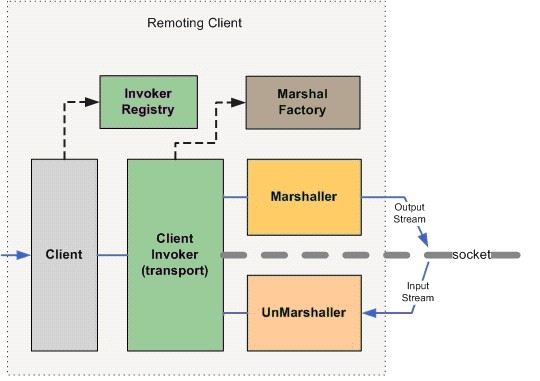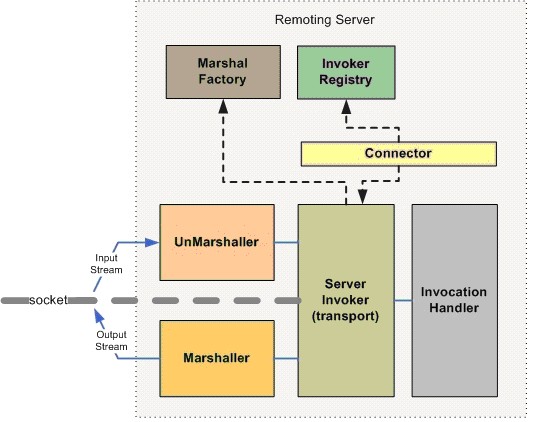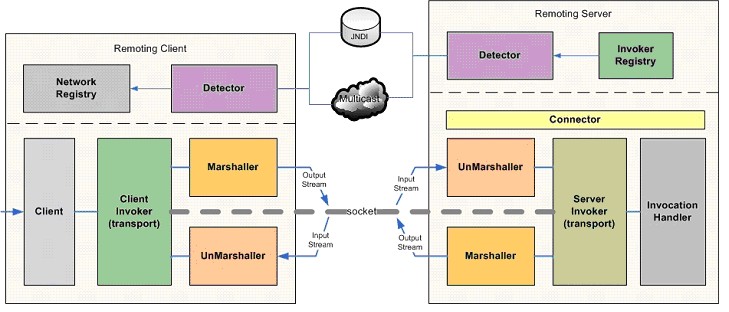The most critical component of the JBoss Remoting architecture is how servers are identified. This is done via an InvokerLocator, which can be represented by a simple String with a URL based format (e.g., socket://myhost:5400). This is all that is required to either create a remoting server or to make a call on a remoting server. The remoting framework will then take the information embedded within the InvokerLocator and construct the underlying remoting components needed and build the full stack required for either making or receiving remote invocations.
There are several layers to this framework that mirror each other on the client and server side. The outermost layer is the one which the user interacts with. On the client side, this is the Client class upon which the user will make its calls. On the server side, this is the InvocationHandler, which is implemented by the user and is the ultimate receiver of invocation requests. Next is the transport, which is controlled by the invoker layer. Finally, at the lowest layer is the marshalling, which converts data type to wire format.

When a user calls on the Client to make an invocation, it will pass this invocation request to the appropriate client invoker, based on the transport specified by the locator url. The client invoker will then use the marshaller to convert the invocation request object to the proper data format to send over the network. On the server side, an unmarshaller will receive this data from the network and convert it back into a standard invocation request object and send it on to the server invoker. The server invoker will then pass this invocation request on to the user’s implementation of the invocation handler. The response from the invocation handler will pass back through the server invoker and on to the marshaller, which will then convert the invocation response object to the proper data format and send back to the client. The unmarshaller on the client will convert the invocation response from wire data format into standard invocation response object, which will be passed back up through the client invoker and Client to the original caller.
Client
On the client side, there are a few utility class that help in figuring out which client invoker and marshal instances should be used.

For determining which client invoker to use, the Client will pass the InvokerRegistry the locator for the target server it wishes to make invocations on. The InvokerRegistry will return the appropriate client invoker instance based on information contained within the locator, such as transport type. The client invoker will then call upon the MarshalFactory to get the appropriate Marshaller and UnMarshaller for converting the invocation objects to the proper data format for wire transfer. All invokers have a default data type that can be used to get the proper marshal instances, but can be overridden within the locator specified.
Server
On the server side, there are also a few utility classes for determining the appropriate server invoker and marshal instances that should be used. There is also a server specific class for tying the invocation handler to the server invoker.

On the server side, it is the Connector class that is used as the external point for configuration and control of the remoting server. The Connector class will call on the InvokerRegistry with its locator to create a server invoker. Once the server invoker is returned, the Connector will then register the invocation handlers on it. The server invoker will use the MarshalFactory to obtain the proper marshal instances as is done on the client side.
Detection
To add automatic detection, a remoting Detector will need to be added on both the client and the server side as well as a NetworkRegistry to the client side.

When a Detector on the server side is created and started, it will periodically pull from the InvokerRegistry all the server invokers that it has created. The detector will then use the information to publish a detection message containing the locator and subsystems supported by each server invoker. The publishing of this detection message will be either via a multicast broadcast or a binding into a JNDI server. On the client side, the Detector will either receive the multicast broadcast message or poll the JNDI server for detection messages. If the Detector determines a detection message is for a remoting server that just came online it will register it in the NetworkRegistry. The NetworkRegistry houses the detection information for all the discovered remoting servers. The NetworkRegistry will also emit a JMX notification upon any change to this registry of remoting servers. The change to the NetworkRegistry can also be for when a Detector has discovered that a remoting server is no longer available and removes it from the registry.